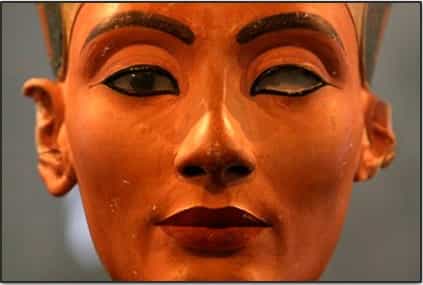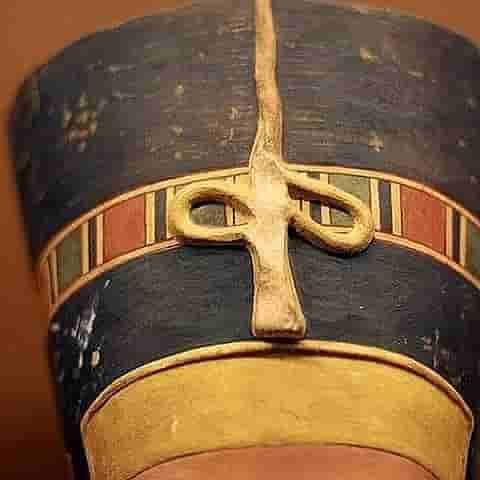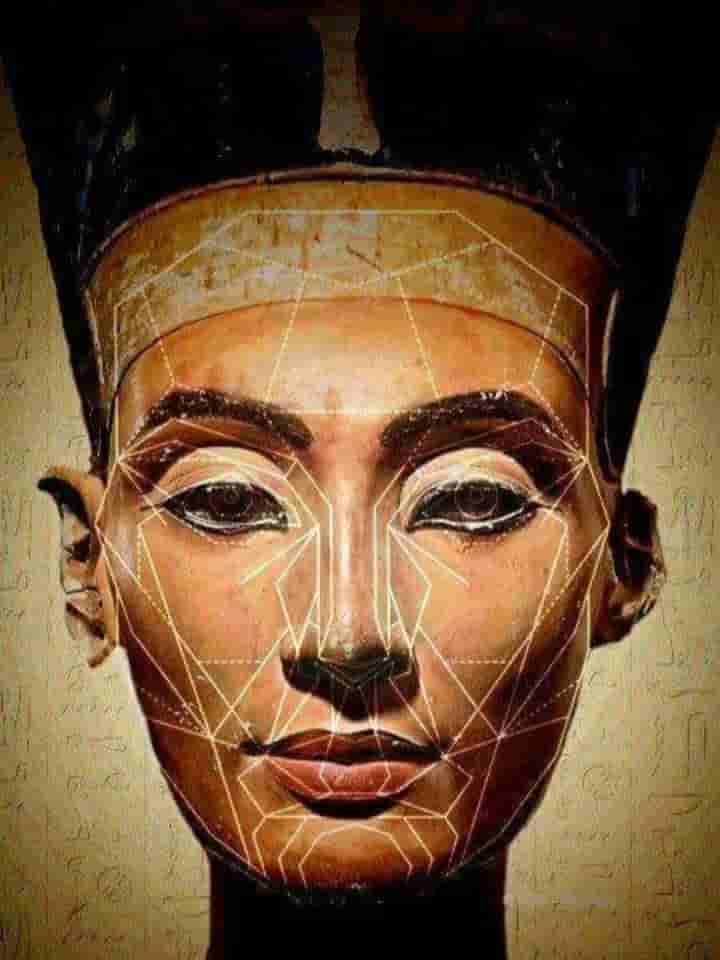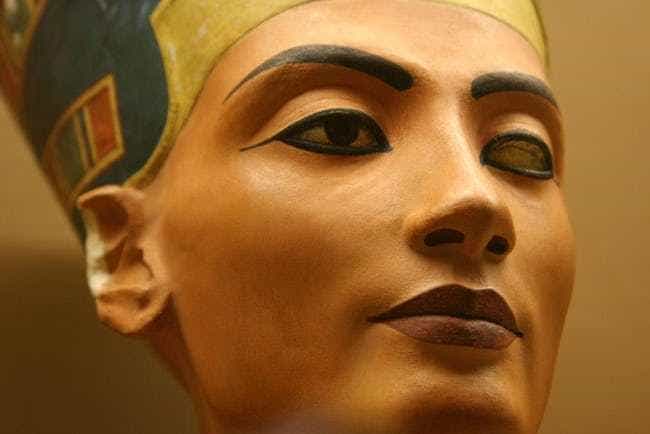On December 6, 1912, an archaeological team from the German Eastern Society found the famous bust of Queen Nefertiti, located in the workshop of the sculptor Thutmose, in the city of Amarna, Egypt.
The bust of 50 centimeters in height is considered an unfinished work – the proof is in the left eye of the sculpture, which does not have an embedded cornea.
The piece, one of the most copied in Ancient Egypt, is part of the collection of the Neues Museum in Berlin.
Few times in the history of mankind the most powerful person in the world has been a woman. In Egypt, however, a beautiful queen led the largest empire in the 14th century BC.
It was a time of prosperity and wealth, thanks to trade relations with neighbors in Mesopotamia and Asia Minor.
It was also a time of peace, when Egyptian diplomacy evolved to the point where unbelievable alliances with peoples that previously only wanted to know about war, like the Mitanni kingdom, emerged.
But behind all this calm, a storm was brewing.
Queen Nefertiti husband: Amenhotep IV
At the age of 16, Amenhotep IV assumed co-regency alongside his father, Amenhotep III, who was already in the 28th year of his reign. In 1352 BC, with the old man’s death, the boy inherited power alone.
Four years later, without further explanation, the new pharaoh changed everything. The cult of the god Amun-Ra, the most important of the time, was replaced by the worship of the sun god Aten, represented by the solar disk.
He changed his name to Akhenaten (meaning the glory of Aten) and spread that he was the new god’s envoy to Earth.
He ordered the construction of the sacred city of Akhetaten (known today as Tell El-Amarna). And there he transferred the capital of Egypt, much to the despair of the priests and the general disagreement of the nation.
When announcing this whole package of changes, he warned: “Nobody, not even my wife, will change my mind”.
Who was Queen Nefertiti?
The influential wife mentioned in Pharaoh’s speeches – a very rare fact for the time and which shows the importance of the queen – was Nefertiti.
It is not known exactly when or where Nefertiti was born. Queen Nefertiti (which means beauty is arrived) only officially came into existence after her marriage to Amenhotep IV.
She was 14 years old. That was when the inscriptions on stelae and talatats appeared, small blocks of stone at the base of Egyptian buildings.
Steles are common in which Nefertiti appears beside her husband with his daughters (there were six in all), scenes of affection and family intimacy are shown.
The young Pharaoh had two wives, but the main one, the one with the title of Great Royal Wife, was Nefertiti. Over time, her influence has grown.
“In the implementation of the new religion, Nefertiti played a fundamental role”, says historian Anna Cristina Ferreira de Souza, from Federal Fluminense University (Universidade) (UFF).
This growth can be seen in the images of the queen engraved on the walls of the temples in Amarna. In the beginning, Nefertiti appears much smaller than Akhenaten.
Over the years, she gets bigger and bigger, until she reaches the size of her husband – an indication that her status has also increased.
Queen Nefertiti power: Atypical growth
The queen’s growth is usually associated with her role in the new religion created by her husband. For the first time, the ancient Egyptian god was unique.
Until then, the religion of ancient Egypt was based on the cult of several gods, whose representatives on Earth were the pharaohs themselves.
The origin of the belief goes back to Prehistory, when local groups worshiped gods and animals. Several gods were worshiped, but one at a time – what was known as monolatry.
When he was still called Amenhontep IV, Pharaoh was already giving evidence of his new faith: he began to build temples for Aten in the city of Karnak, place of worship for Amun-Ra.
Until he made the cult of the solar disk official and ordered the abandonment of the ancient gods.
In the fifth year of his reign, construction began on the new capital, Akhetaten, which was completed three years later. The relationship with the other gods, from then on, was broken.
“Nefertiti had great empathy and charisma among the population, giving some popularity to the cult of Aten, fought by the powerful ancient Egyptian priests, who preferred the traditional gods”, says historian Deborah Vess, from the University of Georgia, in the United States.
“Her beauty, combined with the power she has acquired, has made her one of the most important women in history,” she says.
Nefertiti and Akhenaten
Akhenaten promoted himself and his wife to the position of living gods. In the beginning, the sun god Aten was represented with a human body and a hawk’s head.
Over time, this representation was replaced by images of the royal family, which was always receiving sacred emanations from the solar disk.
“There was a simplification in the hierarchy of the gods of ancient Egypt: only the figures of Aten and the king, who were the only means of access to the divine sphere, remained,” says Anna Cristina.
“The services started to be directed to the royal family, because only they knew and could worship the god.” In this new liturgy, Nefertiti embodied all the female deities that the ancient Egyptians were accustomed to worship.
All of this, however, was also politically motivated. The power of ancient Egypt, a kingdom in which religion and politics were mixed, was previously concentrated in the hands of the priests of Amun.
In the new religion, it became exclusive to the royal couple. From the beginning, the changes attracted opposition from powerful priests.
“Those who were smart and changed their religion had their jobs guaranteed,” says Egyptologist Antonio Brancaglion Junior, from the Federal University of Rio de Janeiro (UFRJ). “Those who did not end up being persecuted arrested and banned.”
Dissatisfaction reached the nobility, bothered by the extreme concentration of power of the pharaoh and his family, and finally the people, affected by the construction of the new city – which led to higher taxes and inflated prices.
Furthermore, Pharaoh had no vocation for war or politics. During his reign, ancient Egypt lost its territories in Asia to the Hittites, which reduced the collection of gold and taxes.
Widow and powerful
This was the climate in 1336 BC, when Akhenaten died, probably from natural causes, at age 34. At that time, Nefertiti’s images show her wearing typical Pharaoh vestments, such as crowns and batons.
For most experts, the fact suggests that she would have assumed the throne of ancient Egypt – first alongside her husband and, after Akhenaton’s death, as his successor.
“Although the subject remains controversial, the opinion that she has ruled as the single queen is now increasingly accepted,” says Brancaglion.
Stone engravings found during excavations in the 19th century in Amarna show that, after Akhenaten‘s death, ancient Egypt was ruled by a pharaoh named Neferneferuaten – who would, in fact, be Nefertiti.
For Zahi Hawass, former secretary general of the Supreme Council of Egyptian Antiquities, there is no doubt about the power accumulated by Nefertiti after her husband’s death.
“Amarna’s images show the queen alone, leading religious processions and even leading armies, positions reserved exclusively for the pharaohs,” says Zahi.
Critics of this thesis call attention to the fact that Akhenaten’s successor revoked almost everything Pharaoh did during his reign – the cult of Aten was extinguished and the ancient gods were resumed less than five years after his death. Why would Nefertiti abandon her husband’s religion?
Anna Cristina has some chances. “Akhenaten left Egypt in crisis. After his death, various sectors of society revolted against the throne.
The return to the cult of Amun-Ra must have been a way that the new pharaoh found to count on the support of the greatest possible number of people and pacify the country “, she says.
This would justify the fact that Nefertiti changed her name and tried to break ties with the old regime. “It was an important decision, made by a woman who was exactly aware of her role in state policy.
“Brancaglion agrees that Nefertiti’s motivation must have been political.”She probably realized that the new religion was causing ancient Egypt to collapse,” he says.
Despite this, Nefertiti was unable to stop the religious and social crisis that led ancient Egypt to a period of political instability. After only three years of power, she would have died in an unclear situation.
Ancient Egypt came to be ruled by the young Tutankhamun, who took over at the age of 9 and died at the age of 19.
Source: CLAUDIA DE CASTRO LIMA, Aventuras na historia
Pictures of Queen Nefertiti











